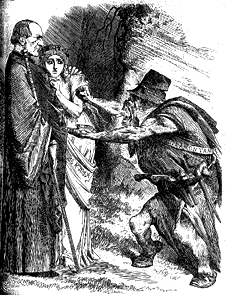

 ut of the vast number of cartoons presented in Punch, one of the most striking and horrific is "The Irish 'Tempest.'" The artist,Sir John Tenniel, depicts "Rory of the Hills" as a version of the monstrous Caliban from Shakespeare's "The Tempest," in an untamed and virtually inhuman form. The shape of the Irishman's body and face attest to the animalistic characteristics that usually accompanied English descriptions of the Irish in the nineteenth century. The prognathous jaw and masses of unkempt facial hair render the Irishman more apish than human. His body as a whole, a massive torso supported on muscular but goatish legs, adds to this animalistic portrayal. Moreover, the Irishman's thick, dagger-like teeth, his slouched, thrusting body, his clenched and outstreched fist, and his store of weapons all emphasize the aggressiveness and violence that the English attributed to the Irish. The upright figure of Gladstone, protecting the lovely and frightened lady Hibernia, provides a contrast which renders the Irishman even more repulsive and brutal: although Ireland itself is depicted as the beautiful, innocent Hibernia,the Irish
Fenians (and other discontented groups) are depicted as the threatening, ragged "Rory"/Caliban. The cartoonist, playing off the quotation from "The Tempest," arms Gladstone with a wizard's robe and the magic staff of his Irish Land Bill, thus creating a Prospero to contend with Caliban and his claim to the land via the witch Sycorax. The division of the landscape in the background emphasizes the division between England and Ireland but allows Gladstone/Prospero and "Rory"/Caliban to "stand their ground" on the same land. The cartoon presents the crux of the conflict over the Irish Land Bill and the Irish Question in general: Should the Irish be allowed to govern themselves or should the English "save" Ireland from her own people?
ut of the vast number of cartoons presented in Punch, one of the most striking and horrific is "The Irish 'Tempest.'" The artist,Sir John Tenniel, depicts "Rory of the Hills" as a version of the monstrous Caliban from Shakespeare's "The Tempest," in an untamed and virtually inhuman form. The shape of the Irishman's body and face attest to the animalistic characteristics that usually accompanied English descriptions of the Irish in the nineteenth century. The prognathous jaw and masses of unkempt facial hair render the Irishman more apish than human. His body as a whole, a massive torso supported on muscular but goatish legs, adds to this animalistic portrayal. Moreover, the Irishman's thick, dagger-like teeth, his slouched, thrusting body, his clenched and outstreched fist, and his store of weapons all emphasize the aggressiveness and violence that the English attributed to the Irish. The upright figure of Gladstone, protecting the lovely and frightened lady Hibernia, provides a contrast which renders the Irishman even more repulsive and brutal: although Ireland itself is depicted as the beautiful, innocent Hibernia,the Irish
Fenians (and other discontented groups) are depicted as the threatening, ragged "Rory"/Caliban. The cartoonist, playing off the quotation from "The Tempest," arms Gladstone with a wizard's robe and the magic staff of his Irish Land Bill, thus creating a Prospero to contend with Caliban and his claim to the land via the witch Sycorax. The division of the landscape in the background emphasizes the division between England and Ireland but allows Gladstone/Prospero and "Rory"/Caliban to "stand their ground" on the same land. The cartoon presents the crux of the conflict over the Irish Land Bill and the Irish Question in general: Should the Irish be allowed to govern themselves or should the English "save" Ireland from her own people?
[Victorian initial "O" by Harlan Wallach ęcopyright 1994.]